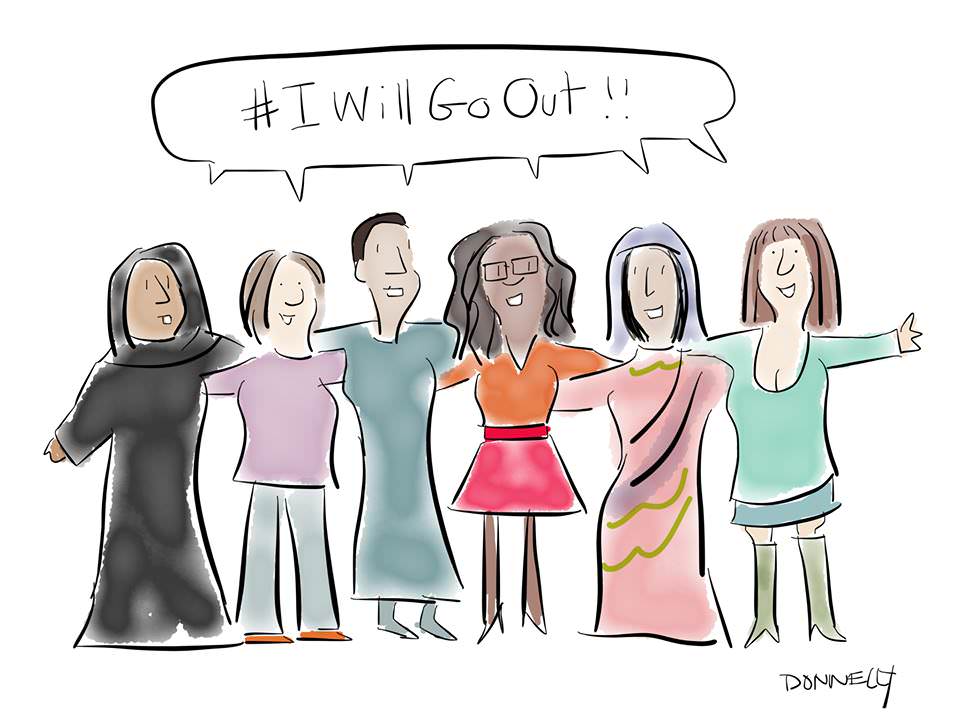Posted by Zoya Vallari
On Saturday, January 21, women in two countries, United States and India, both of which I call home, would come out on streets in multiple cities to raise slogans, chant, sing, shout, ask questions and demand actions. At 5 pm IST, when women in India would be fearlessly reclaiming the night, their sisters in the US would be getting ready early in the morning to take the streets of Washington DC by hundreds of thousands.
The rally in India was triggered by the appalling incident of mass molestation on New Year’s Eve in the city of Bangalore. This march is aptly called ‘#IWillGoOut’. The ‘I’ in the title asserts a woman’s agency to decide her own actions, behaviour, clothes or timings. The ‘Will’ describes a wilful act of protest in the face of harassment that women experience when they claim their agency. The ‘GoOut’, seemingly straight-forward, stands for multiple things – go out to protest, go out to work, go out to party, go out to question the illegal state actions, go out to contest elections or simply to stare at the sky and loiter in the streets because it is ‘I’ who has the agency to decide what I want to go out for.
Also Read: Why Women In India Are Marching On January 21? #IWillGoOut
Meanwhile, the ‘Women’s March on Washington’ has the storied beginning of a woman, Teresa Shook, a retired attorney and a grandmother from Hawaii, creating a social media event on the night after the presidential election only to wake up to see ten thousand people ‘Going’ and a few more thousand ‘Interested’ in attending it. However, this is not the exciting part of the march at all. Having ‘followed’ the event soon after its inception, the growth of the movement every single day has been spectacular.
Shook combined her event with Bob Bland, a fashion designer, who had called for a similar march. When the issue of the organizing team being mostly white was raised a few times, they included non-white activists such as Tamika Mallory, a gun-control activist, Linda Sarsour, the executive director of the Arab American Association of New York and Carmen Perez, who runs Gathering for Justice as National Co-Chairs of the march. It is hard to capture the complex evolution of this movement in short because it was messy and tangled, as any conversation on intersectional feminism ought to be.
Their unabashedly radical policy platform speaks volumes about the journey this movement (and in the process all of us) underwent over the last month.
In the very beginning it states in no uncertain words that “We believe Gender Justice is Racial Justice is Economic Justice”. It points out ‘the gender and racial inequities within the criminal justice system’ and calls for accountability and justice for police brutality. It does not mix words in calling out for complete reproductive freedom (which is strangely still a very contentious topic in the United States). It gives unequivocal support to the LGBTQIA movement, sex workers’ rights movement and also demands the right to clean water and air. It talks about the worker’s rights to organize and the critical importance of unions and labor associations. You can read the complete 4 page platform here.
In the despair created by the current political climate in both India and United States, it is heartening to have these conversations, mobilizations and protests giving women back their voices to say out loud what we want.
This Saturday, January 21, #IWillGoOut and claim the streets to exercise my right to protest. #I(will)MarchFor Gender, Racial and Economic Justice which are intertwined and incomplete without each other. With thoughts of fellow sisters marching back in India and the legacy of women’s marches, I’ll be proud and extremely loud.
About the author(s)
Guest Writers are writers who occasionally write on FII.





Sing? Try this one.
https://www.youtube.com/watch?v=9Ty7WU872Lk